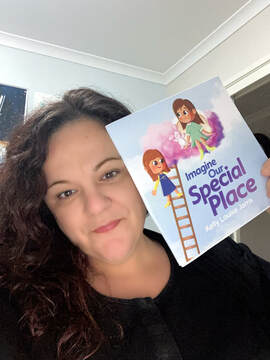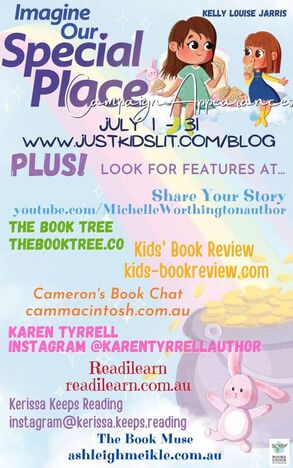Author Interview with Shae Millward for her new book The Rabbit's Magician, ill. by Andy Fackrell.5/9/2022
Hi Shae, and thanks so much for joining me to answer a few questions about your beautiful new book THE RABBIT'S MAGICIAN.
Kerry: This is such a quietly emotive and touching story. What drew you to writing about loss? Shae: I never intentionally set out to write a story about loss – it was certainly not a subject I would have chosen to tackle. The story was inspired by The Law of Conservation of Energy – a fundamental law of nature, which states: Energy cannot be created or destroyed, but it can change from one form into another. I had long known of this scientific principle but had more recently come across a speech by Aaron Freeman about why you want a physicist to speak at your funeral. It was so moving, how the science-talk – which is often cold and clinical – was heart-warming. An impression must have been made on my subconscious because a scene appeared in my mind of a rabbit looking up at the moon. I sensed he was waiting for something. The moon phases changed, and still, he waited. What are you waiting for? I wondered. And then, he told his tale. In a matter of moments, the whole story suddenly existed, like a neatly wrapped gift. No tackling involved. Kerry: You say in your bio that you once thought about a career as a magician. Was this part of your inspiration for the characters of The Amazing Albertino and Ziggy? Shae: In high school, we were asked to write down the career we aspired to have. I wasn’t sure, so I wrote a short-list of occupations that interested or excited me. Magician was one, author was another. The teacher looked at my list and scoffed, ‘Be realistic!’ Well, thanks for teaching your students that they can be and do anything they put their minds to! I’m on the Autism spectrum – this wasn’t known at the time, but it was so disheartening to be told that all of your special interests were unrealistic to aim for. People in positions of power/authority/influence, please use your words thoughtfully. I still love the artform of magic, but I’ve stuck to watching it rather than performing it. Well, watching it, analysing it, studying it. Magic is an art dependent on fooling your brain into experiencing something impossible. Magic can give us that child-like sense of wonder from seeing amazing things happen right in front of our eyes. Now, sometimes I can leave it at that, and just be amazed. Other times, I am too curious and simply must know how a trick is done. I enjoy trying to figure it out. I’m super interested in the psychology of magic and what it can teach us about how our brains work. Our eyes gather information that our brain processes and interprets to help us make sense of the world. The human brain is designed to see structure and logic. It looks for patterns and fills in the blanks. Our brain is reliant on visual cues and it likes to group and organise things in a predictable way. Magicians use this to their advantage. Many people consider magic to be simple entertainment, however, the ancient art of illusion is helping today’s scientists learn more about perception and reality. So, yeah, I gotta lotta respect for magicians. There’s such talent involved in making the impossible seem possible and gifting us that jaw-dropping, eye-popping wonder. Intricate moves, exceptional timing, showmanship, spatial awareness and co-ordination are but a few of the required skills. It also takes dedication, plentiful practise and majestic confidence. Top-hats off to magicians! Anywaaayyy, getting back to the question, I didn’t consciously decide to write about a magician and a rabbit, but the characters of The Amazing Albertino and Ziggy would have certainly been inspired by my deep appreciation of magic. Kerry: Why does the story mostly take place at night? Shae: One of the other themes in the book is the moon and its phases – this dictated that most of the story would take place at night. In the opening scenes, when the rabbit is waiting, the changing phases are used to show the passing of time. In another part, the waning phases represent the magician’s life-force waning. The magician describes the moon as a ‘master of illusion’ because of the ways in which it appears to change shape, but is actually always whole; appears to shine, but doesn’t really make any light of its own; is a dusty old rock, yet we see it as beautiful. Kerry: How did you choose the other characters for the story? Shae: Ziggy's new friends were originally jungle animals. My publisher made a great suggestion to set the story in Australia. I let Andy choose and the animals transformed into a koala, an echidna and a quokka. Presto Change-O! A simple change that adds a touch of our uniquely Aussie magic. The character of Owl represents wisdom. He stayed the same because there are owls in Australia. Kerry: The images in the book create such a beautiful atmosphere. Did you work closely with Andy Fackrell on the illustrations? Shae: Paul put Andy and I in contact from the start, he was happy for us to communicate back-and-forth freely, with him copied in on our emails. So we were able to bounce a lot of ideas around and make good progress. Even though I was in the loop throughout the process, just as The Amazing Albertino surprised and delighted the audience in the story, the amazing Andy surprised and delighted me with each picture. In the opening scenes, the depiction of that darling little rabbit staring up at the moon while his ears droop down captures the sense of waiting and longing. There are some beautiful silhouette moments with the moon as a backdrop that speak of Alby and Ziggy’s close relationship. The spread of Ziggy with the stars, rainbow and flowers has a peaceful ambience in perfect alignment with the words. Kerry: Your first two picture books were written in rhyme. Was there a conscious shift towards writing in prose for The Rabbit’s Magician or was it simply the way the story evolved? Shae: I find that most story ideas come with an intuition about whether they’re best written in prose or rhyme. This story came into my mind in a matter of moments – beginning, middle and end – all very clearly in prose. Kerry: What advice would you give to emerging authors who like to write in rhyme? Shae: Ask someone to read your work While you sit back and listen Places where they stumble, trip Are gonna need some fixin’ Don’t give up, though, if your words Aren’t flowing nice and breezy It’s known for being rather hard To make it sound so easy Kerry: Haha great answer! What has been the most helpful advice given to you on your journey to becoming an author? Shae: It was advice given to me from. . . me! As mentioned in a previous question, many years later, after that teacher told me becoming an author was unrealistic, I was fantasising about giving it a go anyway. One day, my inner voice basically just said, ‘Hey, why don’t you give this writing thing a real go? Come on, you know you want to! Who cares what that teacher said! Write something and actually send it off. Sounds exciting, right? Yeah, sounds fun! You’ve totally got this!’ There may have also been a, ‘You can do it!’ with an awkward self-high-five! Kerry: Great advice from you to you! Thanks so much for sharing your thoughts with us Shae and best wishes to you and Andy for The Rabbit's Magician. The Rabbit's Magician by Shae Millward, illustrated by Andy Fackrell is OUT NOW. Published by Ford St. ISBN: 9781922696076 With thanks to Books On Tour PR & Marketing for helping organise the interview and Ford St. for access to the book.
0 Comments
 This week I got to interview the wonderful Kelly Louise Jarris about her latest book 'IMAGINE OUR SPECIAL PLACE.' Welcome Kelly and thank you for taking the time to interview on The Book Tree Blog. My pleasure and thanks for having me. 'Imagine Our Special Place' is obviously very close to your heart. How important was it for you to get the story out there? This story was inspired by watching two very special people in our family go through palliative care and terminal cancer. Hearing how my sister saw her diagnosis and her positive outlook and how she coped, I saw a strength that I admired. We had small children at the time, and it was really difficult to articulate what was happening and the process that comes with this whole journey. I am hoping I have done that with this book as so many families are dealing with this daily. The illustrations are so bright and playful. Did you collaborate closely with Sandunika Dissanayake? Absolutely, my concept art, references and notes were very thorough. They needed to be as I wanted Sandunika to understand my vision for my story and she definitely did. The story is very uplifting which is not what most people would expect from a story about grief. Was this intentional as an appeal for younger children? It really was and I am so pleased that is what you took from reading my story. I think keeping a child's innocence for as long as possible is so important. My intention for the book was to get kids to use their little imaginations and hopefully create a soothing thought process for such a hard topic to talk about. Do you share or ‘test drive’ your stories with anyone – students, family - before you submit them for publication? Yes, always. I usually get my kids, young nieces and nephews to listen. In fact, they are already quoting lines from my next book, which I love. What has been the most helpful advice given to you on your journey to becoming an author? I was told early on to always surround yourself with people that have your best interests at heart and want to see you succeed and achieve your goals.' Read the book review here. Thanks to Romi Sharp and Books On Tour PR & Marketing for facilitating Kelly's book launch and this interview. Follow Just Write For Kids Blog and the blogs and websites below for more reviews, interviews and information. |
Archives
February 2023
Categories
All
|
|
The Book Tree. © Kerry Gittins 2024. All Rights Reserved. |
Visitors
|
|
|




 RSS Feed
RSS Feed